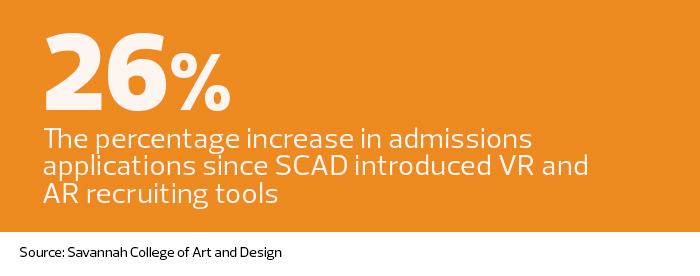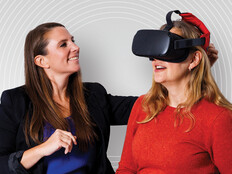College Recruiting Goes Virtual with Immersive Technology
To attract talented athletes, the game day experience can be a recruiter’s most powerful tool. But with only six home games, Iowa State University needed a creative way to showcase games in the offseason. They found it in virtual reality, which lets football players experience a game with the cardinal-and-gold Cyclones. The university’s football coaches partnered with James Oliver, director of the Virtual Reality Applications Center, to recreate Jack Trice Stadium, complete with cheerleaders, a marching band and screaming fans.
The virtual action takes place in the C6, an immersive VR environment in the VRAC. Twenty-four Sony digital cinema 4K projectors display more than 100 million pixels on the walls, floor and ceiling of the 10-foot-by-10-foot room. Back-end power comes from a 48-node cluster and multicore CPUs with high-end NVIDIA graphics cards.
Players wear 3D glasses and interact with the application, which includes opposing players in Iowa Hawkeyes uniforms. “You can fly anywhere in the stadium and play certain animations,” Oliver says. “You can put yourself into the middle of the action.”
All colleges strive to tell a compelling story about their campuses and their offerings that will capture the attention of students, donors and industry partners. Iowa State and other early adopters are finding that high-tech channels can do that and more, often leading to a stronger bottom line.
SIGN UP: Get more news from the EdTech newsletter in your inbox every two weeks!
VR Recruitment Targets Generation Z
Generation Z, the first to grow up entirely in the internet age, is pushing colleges to rethink traditional recruiting. Their expectations shape both form and function, says Amir Rasool, managing director of higher education research at Hanover Research.
First, he says, “they expect content targeted to and tailored for them.” But there’s also a Great Recession effect. Having watched millennials struggle to find jobs and pay off student loans, Gen Z and their parents want to know the expected return on educational investment.
“It is beholden on the university to prove that value to prospective students,” says Rasool, “and one of the best ways to do that is through technology platforms like virtual reality and social media that enable the student to really experience campus life firsthand.”
Create a VR App with Multiple Uses
Oliver’s first challenge was a technical one, he says. Recruiters wanted to take the VR application on the road and into the living rooms of recruits. That meant Oliver and his team had to develop a multiplatform deployment that could be run on a single laptop, with commercial VR headsets such as the HTC Vive.

The team built the application on a game engine platform, then an innovative use of gaming technology that has since become widespread. “The hard part was realistic-looking players and an excited crowd,” Oliver says. “There were lots of little technical hurdles.”
Another challenge was that NCAA rules required the VR application to have a purpose beyond just recruiting football players. So Oliver and his team built the application to support another use case: researching VR platforms and the levels of immersion they create.
When the university embarked on a fundraising campaign for a stadium expansion, the application also helped to engage donor support.
AR Enhances Course Catalogs
Savannah College of Art and Design embraced VR two years ago, shipping Google Cardboard headsets to 30,000 accepted students, along with a question: “What does your future look like?” The headsets let students explore SCAD’s campuses in Savannah, Ga.; Atlanta; Lacoste, France; and Hong Kong.
SCAD next added augmented reality to its recruiting toolkit, enhancing a course catalog with AR videos and animations that play through a custom-built app. The response has been enthusiastic, says Dave Hanak, executive director of interactive services. “We had a 26 percent uptick in our admissions applications ever since our VR went out the door, as well as our AR,” he says.
Before sending out VR headsets to accepted students to help them make enrollment decisions, SCAD took the gear on the road for admissions days. Google Cardboard works with a regular smartphone, so SCAD admission representatives could ask students and parents to pull their own devices out of their pockets and pull up the VR tour.
Hanak says, “The response has been jaw-dropping. SCAD is such a dynamic place, and we often say that you have to see it to believe it.”
The AR catalog lets SCAD gather more than 100 visual media assets and 200 micro-interactions in one place. The catalog stands alone, but in concert with the app, it comes alive.
Part of the tools’ success is that they aren’t just a slick piece of marketing. “What allows us to set ourselves apart is that we have a true business case to feature student work,” says Hanak.
In fact, SCAD teaches AR and VR in many of its programs, so the headset tours and the catalog showcase what students can expect to learn.
Showing Off the Campus Vibe Virtually
When Texas A&M unveiled immersive 360-degree VR tours at SXSW in March, it showed how a campus can serve as a recruitment tool, even when students can’t visit in person. Michael Green, head of emerging and interactive media for the marketing and communications team, understood the vast difference between looking at a map and being on the ground from his own student years as an A&M tour guide.
“When people get on campus here, and they feel the campus vibe, and they feel that Aggie spirit we talk about? They’re going to apply. It’s not even a question,” says Green.
In partnership with a company that specializes in virtual tours and interactive maps, Texas A&M created a powerful tool to convey that famous Aggie spirit, even from a distance. The application works with any VR headset.
More recently, Green has traveled the world with a 360-degree video camera, visiting Texas A&M alumni and researchers from Panama to Palau. Along the way, he created immersive video interviews that showcase Aggies’ impact in their fields. If the campus tours show prospective students what to expect of four years in College Station, the videos demonstrate where they can go with their degrees.
Tech Expands University Outreach
At SCAD, AR and VR have helped to engage donors and secure interest from industry partners and members of the tech industry. Such initiatives also help institutions access new applicant pools.
“With the total pool of college-aged population shrinking, most universities will need to expand recruiting outreach to students who are not geographically nearby,” says Rasool.
Targeted social media ads, for example, can reach students in areas where a college may have less name recognition. VR can then give them a taste of campus life. “If a university offers a slew of tech-focused majors, or if they are competing in a tough market, they can and should use technology as a differentiator,” Rasool says.









